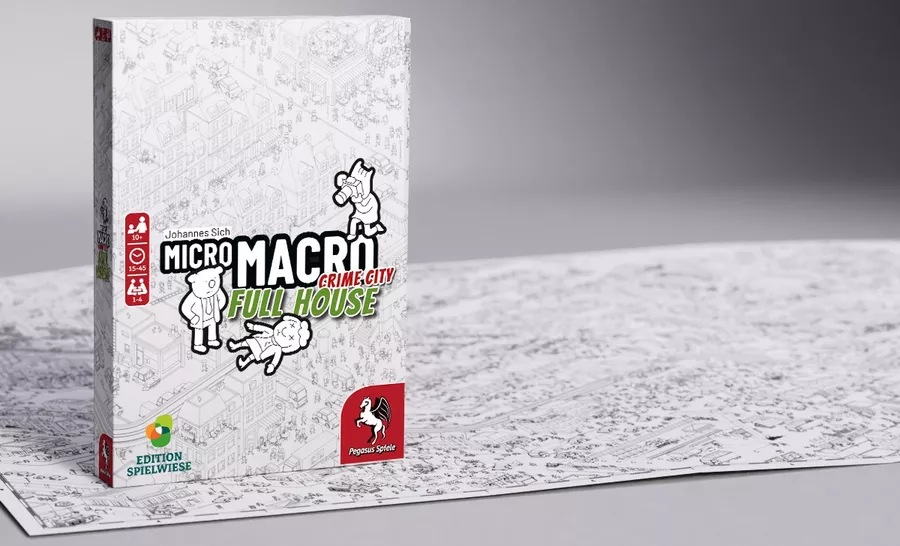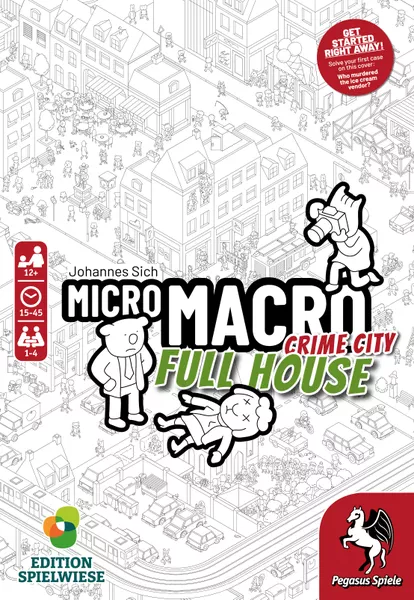Welcome to this week’s gaming post! This week I’m discussing one of the most unique games I’ve played. So without further ado, let’s jump into my review.
MicroMacro: Crime City – Full House
- Designer: Johannes Sich
- Publishers: Edition Spielwiese, Pegasus Spiele
- Complexity: Light
- Time: 15-45 Minutes
- Players: 1-4
- Main Mechanisms: Deduction, Cooperative
MicroMacro: Crime City – Full House is the second game in the MicroMacro series and the sequel to the Spiel des Jahres winning original. I have never played the original MicroMacro, so outside of a couple scenarios of the All In edition, Full House was my first proper jumping in point to the series (thanks to our friends who introduced us to the game). I played through all sixteen cases with my wife and these are my spoiler-free thoughts on the game.
If you’ve never played any of the MicroMacro games, it’s set in a fictional city where as you can probably guess, there’s a lot of crime going on (seriously, a lot of crime). Your goal as investigators at the scene is to solve the cases. To do so, there’s a large (75 x 110 cm) black and white map with cartoon style drawings. The trick is that not everything you see on the map is happening at the same time. The cases generally start off at the scene of the crime, and in order to solve the crime, you’ll have to find the characters in other parts of the map by tracking their movements before and after the crime. In a sense, the game feels like an extension of something like a Where’s Waldo? but with a twist of overlapping scenes.

I can see why the MicroMacro games have received plenty of awards because outside of the Where’s Waldo connection, the game is unlike any other game I’ve played. I respect the amount of time and attention to detail that went into building these elaborate maps, and I imagine the process involved layering many scenes on top of each other. Even without playing the original game, I enjoyed running into characters and scenes from past cases, and over time I started to get immersed in the setting. Which is quite impressive for a game with just drawings.
As I mentioned, the Full House version of the game I played comes with 16 cases that range in terms of complexity. The game is light enough in complexity that it can be played with pretty much anyone, regardless of their experience with board games. Also, while I don’t have any kids of my own, I did appreciate that some of the more mature cases have a warning label, so you can decide ahead of time before playing those with children. The early cases start off pretty straightforward, but once you start getting into the four and five star cases, they do become quite elaborate. There are times where you’ll have to track multiple different suspects across the entire city to figure out if they have a motive and alibi at the time of the murder.
As with most of these types of games, once you’ve solved each of the cases at least once, the game is not exactly repayable. However, it did take us a fair number of hours to get through them all, and there’s more content here than you might initially expect. The game also has an advanced version where you attempt to solve the entire case without using the case cards, which tend to point you in the right direction, and there are also a few additional puzzles you can attempt to solve outside of the cases. At this moment there’s four games in the series, and if you own all four games, I have heard that the four maps can be combined to solve epic cases, which sounds awesome for those who are big fans of the series.
Other than the replayability factor, the only slight negative I have with the game is that I wish the cases came with a few hints when you get stuck. If you’re stuck or when you think you know the answer to a case card, one person flips the card over to reveal the solution. Whenever we ran into that situation, we would still try to figure out how to get to that solution, but it does tend to spoil that feeling of solving it on your own. I wish there was a way to provide hints to nudge you in a certain direction rather than outright giving you the solution to the case.
Finally, since this is a cooperative game, it’s worth noting that depending on your group, there’s always the chance that someone could take charge and dominate the discussion. Also, while the map is pretty large, the drawings are fairly small (there is a small magnifying glass included which is a nice touch), so if you have too many people around the table, someone might have trouble seeing. The game indicates that it plays from one to four players, and while there’s nothing stopping you from playing with more than four, the four person max suggestion was likely included because of this reason. Personally, I think the game is probably best at two because everyone each of you will likely have an equal chance at contributing.
Overall, I really enjoyed playing through all 16 cases in MicroMacro: Crime City – Full House. Even though I probably won’t go back to solve the cases again, I still had plenty of fun during my time with the game. The game is certainly innovative and unlike any other game I’ve played and one I could introduce it to almost anyone, regardless of their familiarity with board games.
With that, I’ll wrap up this week’s review! I’d love to hear your thoughts on any of the games I’ve mentioned, future content, or format in the comments section below. Happy gaming!
If you liked this post and want to be notified when new content is released, then follow me on Instagram @themeepledigest.
